Top Bees for Effective Pollination: A Detailed Guide
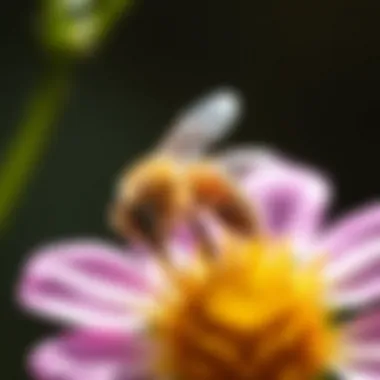
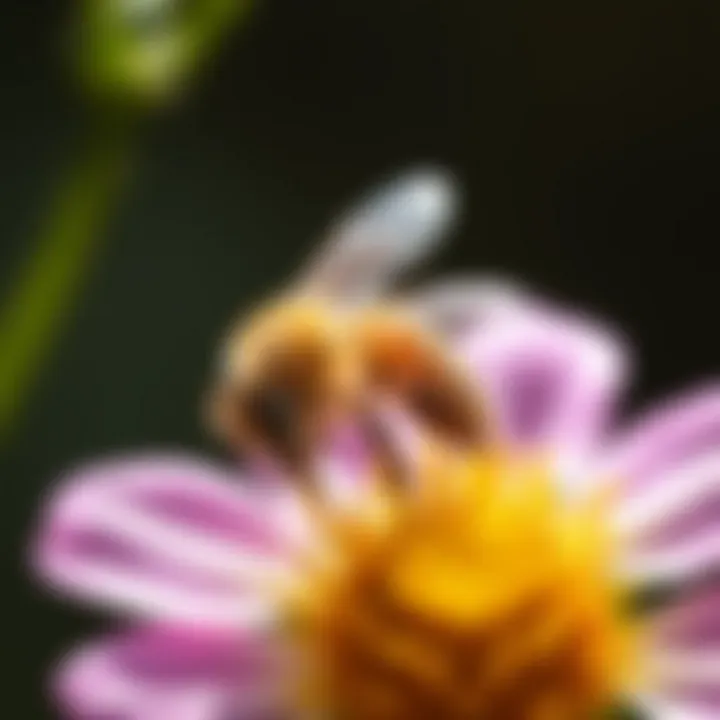
Intro
The world around us thrives with the buzz of bees, an integral part of our ecosystem that often goes unnoticed. These small yet mighty insects play a crucial role in pollination, a process that sustains not only wildlife but also human agricultural practices. The essence of this article lies in understanding which species of bees are the best pollinators, how their behaviors and habitats contribute to biodiversity, and what we can do to foster their populations.
While honeybees often steal the limelight, they are far from the only stalwarts in the pollination arena. Various bee species exhibit unique characteristics that suit them to different environments and flowering plants. For instance, bumblebees are known for their ability to pollinate in cooler conditions, while solitary bees, such as mason bees, can be incredibly efficient due to their individual foraging habits.
As we delve deeper into the topic, we will explore:
- Species of Bees and their Contributions: An examination of various bee species known for their pollination skills, including the habitats they thrive in.
- Impact of Pollinators on Agriculture and Ecosystems: Understanding how these bees support the intricate balance of our ecosystems and the implications for food production.
- Best Practices for Encouraging Bee Populations: Practical advice on creating suitable environments for these essential pollinators, both in agricultural settings and natural woodlands.
This guide aims to open up a conversation about the roles bees play in our world and encourage practices that safeguard their populations, benefiting both nature and agriculture in the long run.
Intro to Pollination and Its Importance
Pollination serves as a cornerstone in the ecosystem, bridging the gap between flowering plants and the myriad of benefits they provide. It is through this vital process that many plants achieve fertilization, leading to fruit and seed production. Without pollination, ecosystems would face dire consequences, leading to a collapse of food chains and a decline in biodiversity. This article aims to unravel the complexities surrounding pollination, particularly by emphasizing the role of bees, which are among the most efficient pollinators.
Defining Pollination
Pollination can be defined as the transfer of pollen from the male part of a flower (the anther) to the female part (the stigma). While it might sound straightforward, the mechanisms and agents of pollination are layered with complexity. Pollinators like bees, butterflies, birds, and even the wind contribute to this process. Each agent has its own methods and efficiencies.
But why does this matter? In simple terms, effective pollination results in higher yields for crops and a vibrant plant community. The intricacies of this process highlight the delicate balance within nature. Without successful pollination, countless plants would fail to reproduce, leading to fewer resources for various wildlife.
Role of Pollinators in Ecosystems
Pollinators, particularly bees, play an indispensable role in maintaining the health of ecosystems. They are responsible for the reproduction of a significant portion of the world’s flowering plants. This not only benefits the plants themselves but also provides food and habitat for numerous animal species. In fact, over 85% of flowering plants depend on animal pollinators for their reproduction.
Imagine a world where fruits, nuts, and vegetables become scarce. Pollinators contribute significantly to the availability of food, thereby sustaining wildlife and the humans who rely on these natural resources. By ensuring that plants can reproduce effectively, pollinators help in maintaining the genetic diversity of flora, which is crucial for resilience against climate change and pests.
Impact on Agriculture
Agriculture cannot be left in the sidelines when discussing the importance of pollination. Many crops, including apples, almonds, blueberries, and cherries, rely heavily on bee pollination. The economic impact is staggering, with billions of dollars tied to the yield of these crops. In the United States alone, pollinators contribute an estimated $15 billion to agricultural productivity annually.
The decline in pollinator populations due to habitat loss, pesticides, and diseases has raised alarms within the agricultural industry. Farmers are now urged to cultivate pollinator-friendly habitats, thus providing the necessary flora for bees and other pollinators to thrive. In pursuing sustainable practices, farmers not only guarantee their own livelihoods but also contribute to the health of ecosystems.
"Without these tiny workforce marvels, the agricultural landscape would look remarkably barren."
Understanding Bee Species
Understanding the various species of bees goes deeper than mere classification; it’s about grasping their unique behaviors and ecological roles. This section focuses on significant aspects that distinguish bee species and their contributions to pollination processes. Each species is a cog in the larger wheel of our ecosystems and agriculture, playing distinct yet overlapping roles that ensure the sustenance of plant life and, by extension, animal life, including humans.
Anatomy and Behavior of Bees
At first glance, bees might appear as simple insects, buzzing around flowers. However, a closer inspection reveals a complex anatomy tailored for pollination. A bee's body is covered in tiny hairs, which are specially designed to collect pollen. This specialized morphology, coupled with their feeding habits, allows bees to transfer pollen effectively from one flower to another.
The behavior of bees, too, is quite fascinating. Take, for example, the foraging patterns of honey bees; they communicate with one another through a dance, indicating the location of flowers filled with nectar. This complex social structure and intercommunication among bees demonstrate their innate ability to adapt to their environment. Such traits highlight why specificity in bee species is crucial for enhancing pollination - each carries a unique set of behaviors that complement different types of flowers.
Types of Bees and Their Roles
Not all bees are created equal, and knowing the different types is vital for appreciating their roles in ecosystems. Here’s a brief rundown of some bee categories:
- Honey Bees: Best-known for their role in honey production, they are also remarkable pollinators. They form colonies and can travel great distances to gather nectar and pollen.
- Bumble Bees: With their larger bodies and strict temperature regulation, these bees can pollinate in colder climates than honey bees. Their unique way of pollination—known as buzz pollination—involves vibrating their bodies to release pollen from certain flowers.
- Solitary Bees: Unlike honey and bumble bees, solitary bees live alone and often have a less complex social structure. Species like mason bees are exceptionally efficient at pollination despite their smaller numbers. They tend to favor specific plants, building nests in hollow tubes or natural cavities.
To summarize, the understanding of bee species encompasses their anatomy and behavior as well as the variety among them and their distinctive contributions. By comprehending these factors, enthusiasts, agriculturalists, and conservationists can tailor their approaches to support these important pollinators effectively. Each bee species enriches the tapestry of our environment, fostering biodiversity, and thus, directly affecting agricultural productivity and ecological balance.
Key Bee Species for Effective Pollination
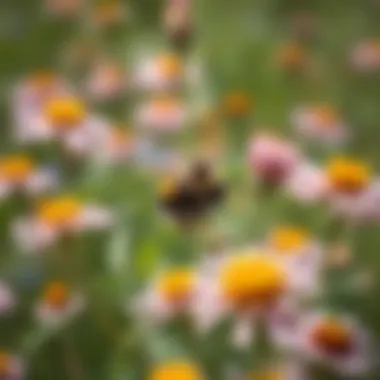

When we talk about bees and their contributions to pollination, it’s easy to imagine honey bees in a field of flowers, but the reality is a bit more nuanced. Understanding the key bee species that excel at this often shows us how varied and complex their roles really are. Each species has its unique anatomy, behavior, and ecological value, which makes them more or less effective in certain environments. Presenting information on these species not only highlights their essential roles but also brings to light various ways we can enhance their habitats and ensure their continued success in pollination efforts.
In this section, we’ll discuss some notable bee species that contribute significantly to pollination. These include honey bees, bumble bees, solitary bees, and mason bees. From characteristics to habitat preferences, every little detail counts when you consider their importance in ecosystmes.
Honey Bees: Characteristics and Impact
Honey bees are perhaps the most talked-about pollinators, and with good reason. These bees are social insects, living in large colonies that can consist of thousands of individuals. Each honey bee plays a vital role in their hive—workers collect nectar, while the queen focuses on reproduction.
One major trait of honey bees is their capacity to communicate using a dance known as the waggle dance, which conveys information about the distance and direction of good floral sources. This unique form of interaction helps maximize foraging efficiency within the colony.
"Honey bees contribute to approximately 80% of all pollination in North America, making them indispensable to agriculture and food production."
Their impact on agriculture cannot be overstated. They pollinate numerous crops including fruits, vegetables, and nuts, contributing to about $15 billion in agricultural value annually in the US alone. However, their reliance on a limited range of crops can also make them vulnerable to environmental changes and habitat loss.
Bumble Bees: Their Unique Pollination Methods
Bumble bees might not be as well-known as honey bees, but they exhibit some distinct advantages that make them exceptional pollinators. These bees are larger and fuzzier, which allows them to carry more pollen; that alone sets them apart. Bumble bees are also known for their ability to perform a technique called buzz pollination. This specialized method involves vibrating their bodies to release tightly packed pollen from certain flowers, like tomatoes and blueberries, ensuring that plants receive adequate pollination.
Unlike honey bees, bumble bee colonies are relatively small and annual, which means new queens leave the nest to start their colonies each spring. This dynamic has implications for habitat requirements and overall bee population sustainability. Supporting bumble bees by providing diverse and native flowering plants can significantly enhance their presence in an area.
Solitary Bees: Lesser-Known Yet Effective
Solitary bees might often go unnoticed, but they play a critical role in pollination. Unlike their social cousins, solitary bees do not form colonies; instead, each female typically constructs and provisions her own nest. This can include varieties such as mason and leafcutter bees.
Their solitary nature means that they often have specific floral preferences, which can make them exceptionally efficient at pollinating certain plants. For instance, leafcutter bees are known to favor roses and clover and can visit multiple flowers in a single trip, which is essential for effective pollination.
By planting diverse blooms staggered throughout the seasons, landowners not only support solitary bees but also promote biodiversity. Recognizing their contributions can be a game changer in ecological management strategies.
Mason Bees and Their Importance
Mason bees, particularly the genus Osmia, are small but mighty when it comes to pollination. They are solitary bees, predominantly nesting in pre-existing holes or cavities—hence the name “mason.”
These bees are incredibly efficient, often visiting a flower for three to four times as long as honey bees, which allows them to collect and deposit more pollen. Mason bees also do not have to travel as far, making them excellent pollinators for home gardens and local crops.
Encouraging mason bees involves creating nesting sites and ensuring availability of food sources throughout their active months in spring. By utilizing bee hotels or enhancing natural nesting sites, individuals can make a significant impact in supporting their populations.
In summary, recognizing the various key bee species and understanding their unique strengths and roles in pollination plays a fundamental part in conservation efforts and sustainable agricultural practices. Through tailored efforts to support these specific populations, we can foster a more resilient ecosystem and secure the future of our food sources.
Factors Influencing Bee Pollination Efficiency
Pollination is a complex process, one that isn’t solely dependent on the bees themselves. Several key factors influence how well these pollinators can do their job. Understanding these elements puts us in a better position to support bee populations and, consequently, the ecosystems and agriculture they bolster. Here, we will delve into three major influences: flower availability and diversity, environmental conditions, and interactions among pollinator species.
Flower Availability and Diversity
The types and number of flowers in an area can dramatically impact bee activity. More often than not, bees have a preference for certain flowers. They are drawn by color, scent, and nectar production.
- Diversity of Blooms: A variety of flowers means a sustained food source throughout the season. If a landscape is dotted with various blooms, bees can forage for longer periods, especially when certain plants start to fade. Think of it like an all-you-can-eat buffet compared to a limited menu at a fast food joint. The former attracts more diners.
- Seasonality: Early flowering plants like crocuses or dandelions can catch the attention of bees emerging from hibernation. Meanwhile, plants that bloom later, such as goldenrods or asters, can provide essential resources as fall approaches. These blooms ensure that bees have food sources aligned with their life cycles.
Diversity doesn’t stop at the types of flowers; also consider the size of flower patches. Larger patches can allow bees to collect nectar more efficiently, minimizing effort while maximizing yield. However, smaller clusters may still attract specialized species.
"A diverse flowering landscape is like a symphony where each flower plays its part, creating harmony for these busy pollinators."
Environmental Conditions
Weather plays a vital role in the world of bees. Take, for example, humidity and temperature. Bees are less active when it’s too cold or wet, impacting their effectiveness as pollinators. Understanding the local climate is crucial.
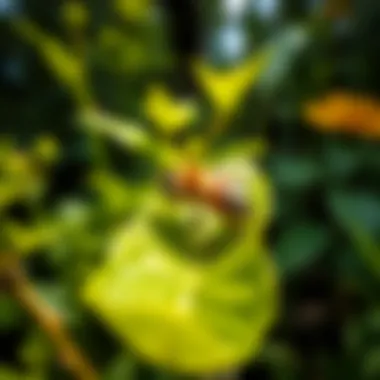
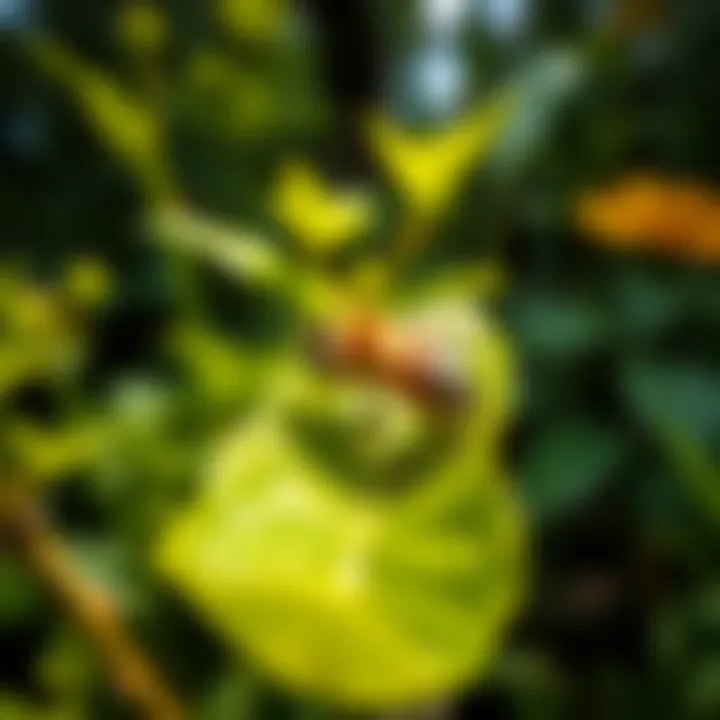
- Temperature: Bees are cold-blooded, and their activity levels are dependent on warmth. Ideal conditions are typically found in temperatures between 60°F and 90°F. Too cold, and they stay dormant; too hot, and they risk dehydration.
- Rain and Wind: Rainy days are generally less favorable for bee activity, while strong winds complicate their foraging efforts. Bees don't have the best navigational skills when buffeted by gusts, leading them to forgo their important work.
- Microhabitats: Localized variations, like sheltered areas versus exposed spots, also affect bee presence and activity. Areas that offer protection from harsh winds and intense sunlight help keep bees active and foraging.
Interactions Among Pollinator Species
It’s not just bees that contribute to plant pollination. A diverse group of pollinators can influence how effectively any single species can operate. Here’s what to consider:
- Competition: In areas where multiple pollinators are present, bees may face competition for the same resources. Different species may favor particular flowers, and if one type of pollinator is more efficient, it can impact how much the bees are able to gather.
- Cooperative Relationships: Interestingly, some pollinator species can work synergistically. For example, butterflies and bees often visit the same flowers at different times, allowing a more thorough pollination process.
- Disruption of Habitats: If habitats are disturbed, the balance between various pollinators can shift. Lost resources can disadvantage not just bees, but a whole network of species, leading to a ripple effect on pollination performance across the board. Proper management of these interactions can maximize efficiency.
Ultimately, the effectiveness of bee pollination isn't just a matter of having more bees buzzing around; it’s about fostering the right conditions for them to thrive. By enhancing flower diversity, being mindful of environmental fluctuations, and understanding the dynamics of pollinator interactions, we can create an ecosystem that supports these vital species.
Best Practices for Supporting Bee Populations
Supporting bee populations is crucial not just for the health of these insects but also for the vitality of our ecosystems and agricultural productivity. As the backbone of pollination, bees play a significant role in ensuring diverse plant life and abundant food sources. With many bee populations declining due to habitat loss and pesticide use, practicing effective measures creates a compelling case for action.
Creating Pollinator-Friendly Habitats
Designing habitats that invite pollinators involves more than simply planting flowers. It requires awareness of the nuances of local ecosystems. Pollinator-friendly habitats should incorporate native plant species that bloom throughout the seasons, ensuring food sources are available year-round. Consider the following:
- Diversity of Flora: Mixing various plant types can attract different bee species. Consider planting wildflowers like black-eyed Susans or milkweed, as they are particularly appealing to many native bees.
- Avoiding Pesticides: Chemical pesticides pose a severe threat to bee health. Opt for organic alternatives or integrated pest management strategies to minimize harm to these vital pollinators.
- Provide Shelter: Bees need places to nest. Adding bee hotels or leaving sections of bare soil can encourage solitary bees to establish their homes.
As we move towards creating these pollinator havens, we must ensure that our approaches are tailored to the unique needs of local bee species, which can vary widely depending on geographical and environmental factors.
"Creating environments where bees can thrive is a win-win; it benefits both our planet and our future generations."
Sustainable Farming Practices
Farming practices are pivotal in shaping the landscapes bees inhabit. Sustainable farming not only conserves resources but also helps maintain healthy bee populations. Here are several practices to consider:
- Crop Rotation: This technique can enhance soil health and reduce pest buildup while providing various blooming crops to sustain pollinators.
- Pollinator Buffers: Planting strips of wildflowers around crop fields can serve as habitats for bees, ensuring they have access to food while benefiting crops through improved pollination.
- Reduced Tillage: Minimizing soil disruption protects nesting habitats for ground-nesting bees, significantly improving local populations over time.
By weaving these practices into farming operations, we not only bolster bee populations but also improve the resilience and nutrition of agricultural systems.
Integrating Bees into Woodland Management
Woodland areas can be transformed into bee sanctuaries through mindful management practices. Incorporating bees into woodland management can provide substantial benefits both to the trees and the bees themselves. Some strategies include:
- Encouraging Understory Growth: Maintaining a healthy understory of flowers benefits bee populations while enhancing forest ecology. Consider planting and nurturing flowering shrubs that can offer food sources.
- Dead Wood Habitats: Leaving dead or decaying trees can create habitats for several bee species, particularly wood-nesting ones. This practice conserves biodiversity and encourages healthy ecosystems.
- Educating the Community: Organizing workshops or informational sessions can encourage local involvement, giving individuals the tools they need to support bee populations effectively.
Through integrating bees into an ecosystem management plan, we can ensure healthier woodlands and foster a symbiotic relationship between flora and fauna.
Monitoring Bee Populations and Health
Monitoring bee populations and their overall health is crucial in the realm of biodiversity and sustainable land management. Bees, being intricate to pollination, directly correlate with the productivity of crops and the balance of local ecosystems. Tracking their populations informs us not only about the bees themselves but also about the environments they inhabit, which can signal potential ecological issues.
Healthy bee populations reflect a robust ecosystem. Conversely, a decline in their numbers can spell trouble for crops, thus creating concern for agricultural yields and food security. Understanding the dynamics of local bee populations empowers forestry professionals and landowners to implement targeted conservation strategies. These efforts can enhance not only the health of bees but also the overall vitality of the agricultural landscape.
Assessment Techniques
When it comes to assessing bee populations, a multitude of techniques is utilized to provide a detailed picture of their health and numbers. Some popular methods include:
- Visual Surveys: Simply observing and counting bees at various flowering plants during peak activity hours. This straightforward approach can yield immediate clarity on the types of bees present and their diversity.
- Trap Methods: Various traps, like pan traps, attract bees using colors and scents, allowing for a more systematic collection. Such traps extend the ability to monitor lesser-seen solitary species.
- Sampling: Collecting bee specimens provides valuable genetic data that can indicate broader health trends and susceptibility to diseases.
- For instance, sampling can include monitoring hive strength in honey bees by analyzing the number of frames occupied by bees.
Data collected through these methods are most meaningful when compared over time, thus revealing trends in population dynamics.


Understanding Bee Diseases
Bee diseases are a grave concern impacting not only individual colonies but also the greater bee population. Understanding these diseases helps in crafting suitable management practices. Common diseases affecting bees include:
- Varroa Mites: A notorious parasite that attaches to bees and feeds on their bodily fluids, leading to weakened bees and potential collapse of the colony.
- Nosema: A fungal infection that affects the gut, impacting the productivity and lifespan of bees.
- American Foulbrood: A bacterial disease that devastates bee larvae, often requiring strict treatment protocols to mitigate its effects.
Educating beekeepers about these threats and encouraging early detection measures can mean the difference between a thriving colony and one that succumbs to disease. Effective disease management practices not only reduce mortality rates but also boost the resilience of bee populations.
"Monitoring and assessing bee health is not just about saving bees; it's about preserving our crops, ecosystems, and future food security."
*
To sum it up, keeping a vigilant eye on bee populations and their health is not merely academic; it’s a pressing responsibility for those engaged in forestry and agriculture. As we observe, assess, and understand, we contribute essential knowledge that fuels efforts in conservation. For further information on bee health and monitoring techniques, consider checking resources such as the USDA and the University of California Agriculture & Natural Resources.
*
Conservation Efforts for Bees
Bees play an irreplaceable role in both ecosystems and agricultural systems, making conservation efforts crucial not only to their survival but to the health of our planet. It’s pretty clear that as bees face increasing threats, such as habitat loss, pesticide exposure, and climate change, substantial conservation efforts are imperative. By adopting these initiatives, we can help bolster bee populations and ensure they continue their vital pollination work.
Local and Global Initiatives
Many initiatives, both local and global, have emerged to protect bee species and their habitats. Local efforts often focus on educating the community about the significance of bees and how to create friendly environments for them. This could include planting native flowers in gardens and reducing pesticide use, which harms these essential insects.
Globally, organizations are championing laws and policies aimed at bee preservation. For instance, several countries have begun implementing bans on particularly harmful pesticides, recognizing their detrimental impact on bee populations.
Here are a few noteworthy examples of initiatives:
- The Pollinator Partnership: This organization promotes education and conservation efforts across all levels of society, aiming to sustain pollinator populations.
- Bee City USA: This initiative encourages cities to create habitats for pollinators by implementing policies focused on pollinator preservation and habitat creation.
- European Union’s Pollinator Initiative: It emphasizes research, public awareness campaigns, and stricter regulations on harmful pesticides.
Such local and global measures provide not only protection for bees but also enhance public engagement in conservation efforts. When communities recognize their impact and take action, the ripple effect can be significant.
Community Involvement
Community involvement acts as the backbone of conservation efforts. When individuals and groups engage in local initiatives, they create a grassroots movement that can lead to substantial changes. Some contributing actions could include:
- Organizing Workshops: Educating fellow community members about bee species, needs, and behaviors can foster a more empathetic relationship with these creatures.
- Creating Pollinator Gardens: Local residents can work together to transform underutilized spaces into vibrant gardens that attract and support bee populations, fostering biodiversity.
- Volunteering for Local Conservation Groups: Many local organizations are in constant need of help with efforts ranging from planting flowers to conducting bee counts.
“Every action counts when it comes to conservation. Whether it's planting a single flower or advocating for local policies, we can all contribute to the well-being of our buzzing friends.”
By empowering communities to take action, we strengthen bee populations and initiate a lasting cultural shift towards environmental stewardship. Successful conservation not only benefits bees but enriches human lives by enhancing local biodiversity and promoting environmentally sustainable practices.
In summary, conservation efforts for bees are essential for multiple reasons. The combination of educational initiatives, active community involvement, and policy changes is what can tilt the balance in favor of these fragile pollinators. Together, building a hive of support can prove to be the key to ongoing bee preservation.
End and Future Perspectives
The relationship between bees and their environments underlines a critical component of ecological balance and health. As we move forward, recognizing the ongoing significance of bees is not just a matter of environmental concern; it resonates through agricultural productivity, biodiversity preservation, and even our food security. Without robust populations of bees, many crops and wild plants would see diminished yields, translating into less food on our tables and a decline in the natural beauty of our landscapes.
The Ongoing Importance of Bees
Bees are often dubbed the unsung heroes of our ecosystems, and for good reason. They facilitate the reproductive cycle of plants, ensuring that fruits and seeds develop appropriately. While honey bees are well-known, many other species contribute significantly to pollination. Diversity in bee species corresponds with resilience in floral communities. For example, certain types of bumble bees excel in colder temperatures that honey bees might avoid, allowing for a broader geographical range of flowering plants to flourish. This diversity creates a buffer against the impacts of climate change, where some species may thrive while others dwindle.
- Pollination Services: The economic value of pollination by bees is estimated to be in the billions. An array of crops, from apples to avocados, relies on these industrious insects.
- Biodiversity Enhancement: More than just a source of honey, bees enhance plant diversity. This is essential for creating habitats for various wildlife and maintaining ecosystem health.
- Indicator Species: Bees are great indicators of environmental health. A decline in bee populations can signal larger problems in the ecosystem, prompting further investigation and action.
"Bees are the very essence of nature’s balancing act; without them, the equilibrium is under threat."
Encouraging Sustainable Practices
For forestry professionals and landowners, the emphasis on sustainable practices should not be taken lightly. To succeed in enhancing bee populations, it is crucial to integrate environmentally friendly methods into existing agricultural and forest management protocols. Here's how:
- Flowering Plants: Planting a variety of flowering plants throughout the year creates a reliable food source for bees. Native species often attract local bee populations better than non-native varieties.
- Pesticide Usage: Reducing or entirely eliminating harmful pesticides can directly increase bee survival rates. Understanding the timing and types of chemicals used in landscapes helps protect pollinators.
- Habitat Preservation: Maintaining natural habitats allows bees to thrive. Practices such as leaving patches of wildflowers or creating bee hotels can provide safe spaces for nesting and foraging.
By taking these steps, we can partner with nature rather than combat it, promoting not just bee health, but also the resilience of the entire ecosystem. The symbiotic relationship between humans and bees is a path toward sustainability that we need to tread carefully, ensuring future generations inherit a thriving, balanced environment.















